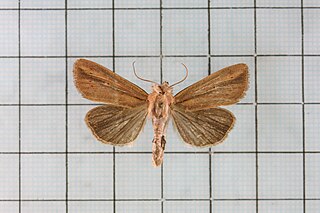
Eucyclodes gavissima, the Oriental orange banded green geometer moth, is a species of moth of the family Geometridae described by Francis Walker in 1861. It is found in the Indian subregion, Sri Lanka, Bhutan, western China, Taiwan, Vietnam, Sumatra and Borneo.

Ramadasa pavo is a moth of the family Noctuidae first described by Francis Walker in 1856. It is found in south-east Asia. including Sumatra, Borneo, Sabah, Sulawesi, Thailand, Sri Lanka, India and China.

Hypena iconicalis is a moth in the family Noctuidae first described by Francis Walker in 1859. It is found in India, Sri Lanka, Taiwan, Papua New Guinea and Fiji.

Hypena lignealis is a moth in the family Noctuidae described by Francis Walker in 1866. It is found in Sri Lanka, Taiwan and Japan.

Mythimna pallidicosta is a moth in the family Noctuidae first described by George Hampson in 1894. It is found from north-eastern India to western China, Sri Lanka, Taiwan, Sundaland, Flores, the Philippines and Japan.

Scirpophaga incertulas, the yellow stem borer or rice yellow stem borer, is a species of moth of the family Crambidae. It was described by Francis Walker in 1863. It is found in Afghanistan, Nepal, north-eastern India, Sri Lanka, Bangladesh, Myanmar, Vietnam, Thailand, Malaysia, Singapore, Sumatra, Java, Borneo, Sumba, Sulawesi, the Philippines, Taiwan, China and Japan.

Lamoria anella is a species of snout moth described by Michael Denis and Ignaz Schiffermüller in 1775 found in Africa, Asia and Europe.
Lamoria adaptella, the plain lamoria, is a species of snout moth in the genus Lamoria. It was described by Francis Walker in 1863 and is known from South Africa, the Gambia, Kenya, Mozambique, India, Sri Lanka, Indonesia and Singapore, as well as Japan and Taiwan.
Ancylolomia chrysographellus, the angled grass moth, is a species of moth in the family Crambidae. It is found on Cyprus and in Kenya, Uganda, Yemen, India, Pakistan, Sri Lanka, Myanmar, China, Korea, Japan, Taiwan, the Philippines and Indonesia.

Lacera alope, the toothed drab, is a moth of the family Erebidae. The species was first described by Pieter Cramer in 1780. It is found in Africa, where it is known from southern and eastern Africa, including several islands of the Indian Ocean, Saudi Arabia, and southern Asia from India, Sri Lanka to China.
Carbia pulchrilinea is a moth in the family Geometridae. The species was first described by Francis Walker in 1866. It is found in the Indian subregion, Sri Lanka and New Guinea, as well as on Borneo, the Mentawai Islands and the Bismarck Archipelago. The species is found from lowlands to the upper montane forest zone.

Autoba abrupta is a species of moth of the family Erebidae. It is found in Papua New Guinea, Thailand, and Australia. The species is largely used by the name Eublemma abrupta in Indian and Sri Lankan texts.
Racotis boarmiaria is a species of moth of the family Geometridae described by Achille Guenée in 1857. It is found in India, Sri Lanka, Maldives, Myanmar, China, Japan, Taiwan, Indonesia, Bhutan and Malaysia.
Calamotropha atkinsoni is a moth in the family Crambidae. It was described by Philipp Christoph Zeller in 1863. It is found in south-east Asia, where it has been recorded from India, Sri Lanka, Thailand, Singapore and Sulawesi.
Calamotropha delatalis, is a moth in the family Crambidae. It was described by Francis Walker in 1863. It is found in Sri Lanka and Australia, where it has been recorded from Queensland, New South Wales and Victoria.
Roxita adspersella is a moth in the family Crambidae. It was described by Pieter Cornelius Tobias Snellen in 1893. It is found in Sri Lanka.
Surattha invectalis is a moth in the family Crambidae. It was described by Francis Walker in 1863. It is found in Sri Lanka, India, Java, Indonesia, Myanmar, and Kenya.
Prionapteryx scitulellus is a moth in the family Crambidae described by Francis Walker in 1866. It is found in India, Sri Lanka and Kenya.
Donacaula dodatellus is a moth in the family Crambidae. It was described by Francis Walker in 1864. It is found in China (Yunnan), Japan, India, Myanmar, Sri Lanka, the Philippines and on Sumatra.
Acantholipes trajecta is a species of moth in the family Erebidae first described by Francis Walker in 1865. It is found in South Africa, India, Sri Lanka, and Australia, where it has been recorded from Western Australia, the Northern Territory and Queensland.






